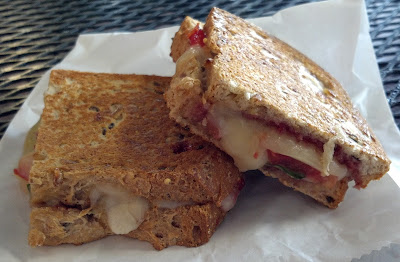Former U.S. Steel employee Gary Condon of North Strabane Township, Pa., right, leads a tour of Carrie Furnaces. (Scott Beveridge photo)
By Scott Beveridge
RANKIN, Pa. – Gary Condon went into a routine meeting with other steelworkers at the Homestead Works of U.S. Steel on a Thursday in 1981, expecting to learn his schedule for the upcoming week.
But, instead, his supervisor instructed the crew at the 10 a.m. meeting to begin banking the row of seven Carrie Furnaces in Rankin for their shutdown the following Saturday.
"He said, 'We'll never turn them on again,'" said Condon, 60, of North Strabane Township, Pa., who once worked as a pipefitter at the historic blast furnaces just south of Pittsburgh .
Condon often revisits his former workplace now to tell stories and lead tours through what remains of these rare examples of pre-World War II blast furnaces, the only ones still standing in the Pittsburgh region.
"It's like coming home. The pipes around here, I worked on every one of them," said Condon, who lived in nearby Bethel Park when the mill was running.
"So much of this has been torn down so it's hard to imagine what all went on here," he said on a May 5 tour of Carrie Furnaces.
Nothing, however, would have remained at the site on eastern banks of the Monongahela River just south of Pittsburgh had it not been for the efforts of local residents who took on big business to preserve their history.
The Cleveland-based Park Corp. purchased the 430-acre brownfield after U.S. Steel forever closed the mill July 25, 1986, and reinvented most of the property at the Waterfront, a string of strip malls, restaurants and theaters. The corporation was in the process of dismantling Carrie Furnace No. 7 when a court battle halted demolition.
"It was a grassroots effort to say, 'Wait a minute. You can't wipe away our history. We have to save some of it,'" said Ron Baraff, director of archives and museum collections at the Homestead-based Rivers of Steel Heritage Corp., the nonprofit that manages Carrie Furnaces.
The organization also saved the mill's pump house, the site of the infamous Battle of Homestead waged in 1892 when Carnegie Steel Corp. hired Pinkertown guards to quell a lockout of Amalgamated Association of Iron and Steel Workers. Seven steelworkers and three detectives were killed in the battle, which dealt a crushing blow to the U.S. labor movement.

Visitors make their way around the seemingly frozen-in-time Carrie Furnace No. 6, part of the infamous Homestead Works near Pittsburgh. (Scott Beveridge photo)
Rivers of Steel was determined to memorialize the mill's role, which went far beyond the battle, as it once employed 15,000 workers and produced a third of all of the steel used in the United States, Baraff said.
"It's the story of the growth of this region, the growth of this country," he said.
Tens of thousands of families immigrated from Europe to work in Pittsburgh's steel industry, which produced materials that allowed the nation to "grow vertically and expand westward," he said.
Steel manufactured at Homestead forms the gates of the Panama Canal and Gateway Arch in St. Louis, and gives structural support to the Empire State Building, U.S. Steel Tower in Pittsburgh and Willis (Sears) Tower in Chicago.
The fate of the last of the Carrie Furnaces, Nos. 6 and 7, wasn't sealed, though, until June 2010, five years after Allegheny County purchased the site from Park Corp. in a $7.2 million investment. The deal allowed Rivers of Steel to trade the Hot Metal Bridge it owned from the site into Homestead, which the county needed for access into the property, for management rights of the furnaces, said Sherris Moreira, the heritage corporation's marketing and tourism director. The organization has begun raising money to convert a large building on the property into a regional steel museum, she said.
"There's a lot of history here. It's the real stuff," said Howard L. Wickerham III of Peters Township, who once worked here as an electrician and is being trained as a guide for tours the nonprofit now offers of the site.
Meanwhile, Condon explains how raw materials – iron ore, limestone and coke – were offloaded by rail to make pig iron in the furnaces. Larrymen would measure the correct amounts of the ingredients into skip cars, which carried the mix into the furnaces. Hot air was then blown into the furnaces to suspend the materials until they melted, a process that separated the iron from the slag. Other workers around the base of the 2,000-degree furnace manually opened gates that permitted the iron to flow into troughs and drain into torpedo-shaped rail cars, which carried it across the Mon to form steel.
Near the base of Carrie No. 6, Wickerham tells a story that best describes the fortitude of the men who once worked here. A coworker smashed his thumb with a sledgehammer, only to remove his glove, wrap the injury with electrical tape and resume his duties.
"He turned to me and said, 'You didn't see anything,'" Wickerham said, adding that such accidents resulted in five days off without pay.
"It was noble work."
A torpedo-shaped railcar that has survived its days of carrying hot metal across a bridge over the Monongahela River to the U.S. Steel Homestead Works. (Scott Beveridge photo)
This story first appeared in the Observer-Reporter newspaper in Washington, Pa.







